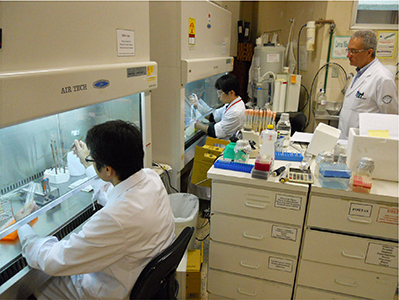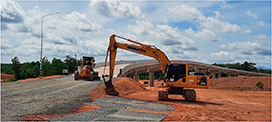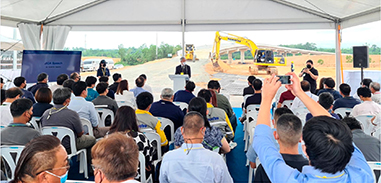(3) Promotion of Information and Communications Technology (ICT), Science, Technology, and Innovation, and Research and Development
The dissemination of Information and Communications Technology (ICT) Note 17 contributes to the upgrading of industry and improvement of productivity. It also contributes to solving social issues of medical care, education, energy, environment, disaster risk reduction, and other areas, and helps promote democratization by encouraging information disclosure and establishing broadcasting media. Moreover, in order to provide highly competitive products and services and to enhance market competitiveness, it is important to promote Digital Transformation (DX). Note 18
● Japan’s Efforts
■ Information and Communications Technology (ICT)

Young people who released a commercial transporters service app that allows potential customers to select the most suitable transporters as part of the “ICT Innovation Ecosystem Strengthening Project,” a technical cooperation project in Rwanda (Photo: JICA)
Japan promotes “quality infrastructure investment” in the ICT field in developing countries. Note 19 It actively supports the establishment of telecommunications and broadcasting equipment and facilities, the introduction of the technology and systems they require, and relevant human resources development (see also “Project Introduction Columns” on Thailand and Ukraine). Specifically, Japan actively works to support the overseas promotion and the introduction of the Integrated Services Digital Broadcasting-Terrestrial (ISDB-T), Note 20 which has been adopted in a total of 20 countries Note 21 in Latin America and the Caribbean, Asia, Africa, and other regions as of December 2022. In addition, JICA training programs are conducted every year for countries adopting or considering ISDB-T. The Ministry of Internal Affairs and Communications (MIC) also promotes assistance that offers ICT solutions to resolve social issues by way of dialogues and joint projects with partner governments.
Japan also works with the International Telecommunication Union (ITU) Note 22 to provide a variety of development assistance in the fields of telecommunications and ICT to developing countries. Since October 2020, under the COVID-19 pandemic, Japan has cooperated with the ITU to launch Connect2Recover (C2R), which supports developing countries and regions mainly in Africa to draft national strategies for strengthening digital infrastructure and improving their usage environments. Among the pilot projects in the “Giga” initiative Note 23 jointly implemented by ITU and the United Nations Children’s Fund (UNICEF), Japan has provided support for introducing internet connectivity to schools in Rwanda. In 2022, through additional support from Japan, the target countries for C2R were expanded to Benin, the Democratic Republic of the Congo, Kenya, Mozambique, Niger, Sierra Leone, and Zimbabwe, where projects are currently underway.
In the Asia-Pacific region, the Asia-Pacific Telecommunity (APT) Note 24 contributes to the balanced development of the telecommunication services and information infrastructure in the region. In order to promote human resources development related to telecommunications, Japan finances a number of training programs conducted by APT every year. In FY2021, eight training programs regarding issues such as broadband networks and cybersecurity were implemented and attended by approximately 150 people from the APT member states. The trainees utilize Japanese technology for the development of their own countries’ ICT, and Japanese companies’ expansion into the Asia-Pacific region is also expected through introducing Japanese technology systems.
In the Asia-Pacific region, over 2 billion people do not have internet access due to factors including the fragile infrastructure and the inability to afford it. In the Association of Southeast Asian Nations (ASEAN) region and Pacific Island countries, Japan develops an environment to make low-cost, high-speed internet available even in remote islands and areas.
In December 2021, Japan, the United States, Australia, Kiribati, Nauru, and the Federated States of Micronesia jointly announced Japan-U.S.-Australia joint support for the East Micronesia Cable. In July 2022, the Project Executive Board Meeting was held online and attended by the six countries, confirming the steady progress of the project. In these ways, Japan will continue to support the development of quality infrastructure in the Indo-Pacific region in order to realize a “Free and Open Indo-Pacific (FOIP)” in cooperation with the United States, Australia, and other like-minded countries.
With regard to the issues of cyber-attacks that have become key concerns of countries in recent years, Japan and ASEAN have agreed to further strengthen their cooperation. Note 25 As a specific initiative, the “ASEAN-Japan Cybersecurity Capacity Building Centre (AJCCBC)” was established through the Japan-ASEAN Integration Fund (JAIF) Note 26 and conducts cybersecurity exercises and other efforts. A total of 948 people had completed the training by 2022, exceeding the initial target of more than 700 attendances over four years that was set when the Center was opened in 2018 (see Cyberspace for efforts of AJCCBC).
■ Promoting Science, Technology and Innovation, and Research and Development

Japanese and Brazilian medical institutions conducting joint research on fungal infection diagnosis (Photo: JICA)
The Science and Technology Research Partnership for Sustainable Development (SATREPS) program, Glossary Note 27 which links ODA and the science and technology budget, was launched in 2008 to support joint research between research institutions and researchers in science and technology fields in Japan and developing countries. 179 research projects in 53 countries around the world have been adopted by FY2022 (see also “Master Techniques from Japan to the World 1” and “Master Techniques from Japan to the World 2”).
Japan also develops networks among the next generation based on cooperation for human resources development, by strengthening assistance for overseas engineering universities.
In Asia, Japan provides support to the Malaysia-Japan International Institute of Technology (MJIIT), which was founded with the aim of establishing Japanese-style engineering education, by procuring equipment and supplies for education and research and by developing curriculum designs, while also conducting cooperation on education and research with Japanese universities. As of 2022, a consortium has been organized by 29 universities, 2 research organizations, and other institutions in Japan, and people-to-people exchanges between Japan and Malaysia have also been promoted through dispatching Japanese faculty and joint research. Since 2012, Japan has provided scholarships to students studying remote sensing (satellite image analysis) in courses taught by Japanese instructors at the Asian Institute of Technology (AIT) Note 28 located in Thailand, contributing to the development of the human resources who will constitute the crux of the space industry development in the Asian region.
In Mongolia, Japan has implemented the “Higher Engineering Education Development Project” since 2014, in which engineering teachers and researchers from the National University of Mongolia and the Mongolian University of Science and Technology conduct joint research with Japanese universities and research institutes. This project provides opportunities to study abroad. Furthermore, it promotes support for the purpose of industrial diversification by providing equipment such as Artificial Intelligence Training Servers and spark plasma sintering machines to Mongolian universities, and supporting AI development, such as autonomous vehicles, and research on product processing of Mongolian rare metals (for the Egypt-Japan University of Science and Technology (E-JUST), see “Stories from the Field 3”).
Thailand
Promote Infrastructure Development in Thailand by Utilizing Japanese Technology
The Project for Capacity Development and Promotion of Utilization of National CORS Note 1 Data Center
Technical Cooperation Project (September 2020 – February 2024)
In Thailand, work efficiency and productivity enhancement are a challenge in various industries due to a shortage of human resources and a decrease in veteran engineers associated with declining birthrates and aging populations in society. In particular, there is significant demand for infrastructure development and business promotion with ICT construction machinery Note 2 that uses high-precision positioning Note 3 to enable autonomous operations of construction and agricultural machinery. It is important to appropriately operate a network of CORS. However, as multiple government agencies independently set and measure CORS according to their respective purposes of use, errors occurred in positioning data and those agencies were unable to share and mutually use the obtained information. Thus, the Government of Thailand established the National CORS Data Center (NCDC) as a reference station to observe and correct errors that occur in CORS.
Under this project, Japan provides technical assistance to allow NCDC to centrally and accurately analyze and distribute positioning data from CORS, by means of networking 240 CORS across Thailand and by building a network that enables advanced surveying, so that relevant agencies can utilize disseminated information.
In order to promote the utilization of high-precision positioning, Japan publicly invited Japanese and Thai companies to undertake projects. Japan, together with agencies of the Government of Thailand, selected a total of eight projects in the sectors of agriculture, surveying, construction, and automated vehicle operation, and launched pilot projects. In the agricultural sector, a project is underway to develop a method to precisely spray agricultural chemicals using self-driving agricultural helicopters by leveraging high-precision positioning. In the construction sector, a road construction project is underway applying autonomous driving construction machinery, in addition to high-precision surveying and construction by making use of three-dimensional (3D) data, and there are growing expectations for higher quality and efficient construction work with the use of high-precision positioning.
Through these pilot projects, Japan will continue to provide support for industrial promotion and infrastructure development using high-precision positioning, and will contribute to the further stable management of high-precision positioning data.

Road construction using high-precision positioning data and ICT construction machinery (Photo: JICA)

An on-site tour of road construction using high-precision positioning data and ICT construction machinery (Photo: JICA)
Note 1: Continuously Operating Reference Stations (facilities that take an accurate measurement of a position and altitude on Earth by continuously receiving radio waves from a positioning satellite).
Note 2: Heavy machinery in the construction sector that incorporates information and communication technology (ICT).
Note 3: Real-time and accurate measurement of positions and altitudes of data operation anywhere on Earth. It is expected that autonomous construction and agricultural machinery operation, as well as industrial development through the use of autonomous driving technology, can be realized by leveraging high-precision positioning.
- Note 17: ICT is an abbreviation for Information and Communications Technology. It is a technology that integrates computers and other information technology with digital communication technology, as represented by the Internet and mobile phones.
- Note 18: Making people’s lives more convenient and enriching them through the introduction of new information technologies, and generating new value by recreating existing business structures with the introduction of new digital technologies, etc.
- Note 19: In 2017, Japan formulated the Playbook for Investment in “Quality ICT Infrastructure” for ICT policymakers and procurement managers of the respective countries and regions.
- Note 20: A terrestrial digital broadcasting system that was developed in Japan. Its functions, such as an emergency alert broadcast system, TV broadcasting reception on mobile terminals, etc., and data broadcasting, give the system advantages in disaster response and the provision of diverse services.
- Note 21: The 20 countries are Japan, the Philippines, Sri Lanka, Maldives, Argentina, Uruguay, Ecuador, El Salvador, Guatemala, Costa Rica, Chile, Nicaragua, Brazil, Paraguay, Peru, Venezuela, Bolivia, Honduras, Angola, and Botswana.
- Note 22: A UN specialized agency that covers the fields of telecommunications and broadcasting. To ensure that people around the world are able to make use of telecommunications technologies, ITU organizes the following: (i) international allocation of radio frequencies used in mobile phones, satellite broadcasting, and other technologies, (ii) international standardization of telecommunications technologies, and (iii) support for development in the field of telecommunications in developing countries. In 2022, Mr. ONOE Seizo was elected as Director of the Telecommunication Standardization Bureau of the ITU.
- Note 23: An initiative launched by UNICEF and ITU in 2019 with the aim of enabling internet access in schools around the world, focusing on developing countries.
- Note 24: An international telecommunication organization established in the Asia-Pacific region. Aiming for a balanced development of telecommunication services and information infrastructure in the Asia-Pacific region, it implements human resources development through training courses and seminars, and coordinates regional policies on standardization, wireless communications, and other telecommunication issues. Since 2020, Mr. KONDO Masanori has been serving as the Secretary General.
- Note 25: In 2015, the Cybersecurity Strategic Headquarters was established in the Cabinet Secretariat of Japan, and in 2016 the “Basic Policy to Support Cybersecurity Capacity Building in Developing Countries” was reported to the Headquarters.
- Note 26: See Note 4.
- Note 27: See also Part IV 1(5).
- Note 28: One of the Asia’s leading graduate schools offering master’s and Ph.D. programs at the School of Engineering and Technology, the School of Environment, Resources and Development, and other faculties.
